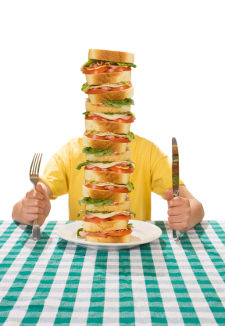Eating Smaller Portions: Painless Tips & Strategies

I have five painless ideas -- and one really uncomfortable one (#6) -- for eating smaller portions while still feeling satisfied. To really make these stick, turn them into habits. No need for willpower!
That uncomfortable strategy I mentioned is a powerful one if you're ready, willing and able to do it.
1) Drink a Glass of Water -- and See If You're Actually Hungry
When your stomach is growling and you smell amazingly delicious food it's too easy to fill a plate (or grab some samples with your bare hands) and dive into the food.But did you know that it's possible to sometimes confuse the feeling of thirst with that of hunger? Your stomach may actually be craving a big glass of water rather than a feast.
Some studies have shown that drinking a glass or two of water before a meal can help reduce the amount of food eaten. And this super-simple tip may even help with weight loss (...just sayin').
Not only will the water start to fill up your stomach before you get to the buffet, leaving less room for the feast but drinking enough water has been shown to slightly increase your metabolism.
Win-win!
See: 3 Questions to Ask Yourself Before Eating That Food You REALLY Want to Eat
2) Slow Down and Eat Mindfully
You've heard of mindfulness but have you applied that to your eating habits?This can totally help you avoid overeating as well as having the added bonus of helping your digestion.
Just as being mindful when you meditate helps to focus your attention on your breathing and the present moment being mindful when you eat helps to focus your attention on your meal.
Do this by taking smaller bites, eating more slowly, chewing more thoroughly, and savouring every mouthful. Notice and appreciate the smell, taste and texture. Breathe.
This can help prevent overeating because eating slower often means eating less.
When you eat quickly you can easily overeat because it takes about 20 minutes for your brain to know that your stomach is full.
So take your time, pay attention to your food and enjoy every bite.
Bonus points: Eat at a table (not in front of the screen), off of a small plate, and put your fork down between bites.
See: How to Eat Slowly and Mindfully
3) Eat a Salad Before the Main Meal
You may be yearning for that rich, creamy main dish.But don't start there.
(Don't worry, you can have some...just after you've eaten your salad).
Veggies are a great way to start any meal because they're full of not only vitamins, minerals, antioxidants, and health-promoting phytochemicals but they also have some secret satiety weapons: fiber and water.
Fiber and water are known to help fill you up and make you feel fuller. They're "satiating".
And these secret weapons are great to have on your side when you're about to indulge in a large meal.
4) Eat More Vegetables
First, remember that vegetables are your best friends! It’s the one food group that you can eat substantial portions of, while ingesting relatively few calories.For example, imagine eating a meal of lean chicken breast, vegetables and brown rice.
Three ounces of chicken breast has less than 150 calories; and 1/2 cup of brown rice has 110 calories.
Now add vegetables: 1 cup of broccoli has less than 60 calories; 1 cup of cauliflower has approximately 30 calories.
That’s only 350 calories for a lot of food! That would certainly fill up your plate and your tummy, right?
Filling half of your plate with vegetables and taking smaller servings of other foods is a sneaky way to eat fewer calories and still feel satisfied.
See: Top 5 Healthy Dark Green Vegetables
5) Trick Your Brain
Using a smaller plate is also helpful, because you won’t see a lot of empty space on a large dinner plate. Take a dessert plate or a soup bowl and eat your meals from it. Again, fill it up with vegetables and only smaller portions of other foods.See: 7 Things You Need to Know About Serving Sizes
6) Figure Out What’s Stopping You -- Notice and Name Your Feelings
Last but definitel not least, it can also be helpful to figure out exactly why you struggle with eating smaller portions. What about it do you fear? What makes you uncomfortable?Try this experiment: at your next meal: take only one small spoonful of each food, and only a 2-inch serving of meat (approximately 1 ounce). Look at the skimpy amount of food on your plate and say to yourself, “This is all I’m going to eat for this meal.”
Then, pay close attention to how you feel.
What thoughts or feelings come up? Most likely, you’ll start thinking things like this: “I can’t eat only this much food! I’ll be starving again in an hour! I need to eat more than this! I don’t want to be hungry!”
Or maybe you'll think you won't be satisifed because food brings you pleasure, or relieves boredom or stress. But food might be stopping you from constructively dealing with your stress, for example.
Whatever thoughts and feelings come up, write them down. Keeping asking yourself "why" you're feeling like this.
Then you’ll have a pretty good idea of the reasons why you overeat. Most often, they will be fears about not having enough, going without, or feeling deprived.
See: Keep a Journal For Progress
(Remember, the above is only an experiment to generate your feelings about eating smaller portions. After the experiment, be sure to serve yourself a proper portion of food suitable for your calorie needs for that meal.)
Once you figure out the "why", then work on finding a solution other than food and overeating.
How to Put These Tips Into Action
Don't just read this article and forget about the tips. Put these tips into action! Here's how:- Pick at least one of these tips to try out for two weeks.
- Once you get that strategy working for you, come back her to pick another tip to work on while still working on the first tip.
- Keep repeating this until you're eating smaller portions and feeling satisfied.
Recipe (Water): Tasty (and beautiful) Pre-Meal Water Ideas
If you're not much of a plain water drinker or need your water to be more appealing to your senses here are five delicious (and beautiful looking) fruit combos to add to your large glass of water:- Slices of lemon & ginger
- Slices of strawberries & orange
- Slices of apple & a cinnamon stick
- Chopped pineapple & mango
- Blueberries & raspberries
Tip: You can buy a bag (or several bags) of frozen chopped fruit and throw those into your cup, thermos, or uber-cool mason jar in the morning. They're already washed and cut and will help keep your water colder longer.
Must Read
How Eating More Often Can Help You Eat Less
Create A Healthy Eating Schedule For Weight Loss
7 Easy Ways to Cut Calories Without Making Big Sacrifices
